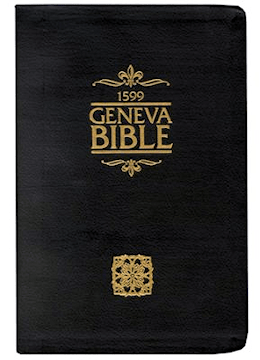Textus Receptus Bibles
Geneva Bible 1560/1599
| 7:1 | So the King and Haman came to banket with the Queene Ester. |
| 7:2 | And the King said againe vnto Ester on the second day at the banket of wine, What is thy petition, Queene Ester, that it may be giue thee? and what is thy request? It shalbe euen perfourmed vnto the halfe of the kingdome. |
| 7:3 | And Ester the Queene answered, and said, If I haue found fauour in thy sight, O King, and if it please the King, let my life be giuen me at my petition, and my people at my request. |
| 7:4 | For we are solde, I, and my people, to be destroyed, to be slayne and to perish: but if we were solde for seruants, and for handmaides, I woulde haue helde my tongue: although the aduersarie could not recompense the Kings losse. |
| 7:5 | Then King Ahashuerosh answered, and said vnto the Queene Ester, Who is he? and where is he that presumeth to doe thus? |
| 7:6 | And Ester said, The aduersarie and enemie is this wicked Haman. Then Haman was afrayde before the King and the Queene. |
| 7:7 | And the King arose from ye banket of wine in his wrath, and went into the palace garden: but Haman stood vp, to make request for his life to the Queene Ester: for he sawe that there was a mischiefe prepared for him of the King. |
| 7:8 | And when the King came againe out of the palace garden, into the house where they dranke wine, Haman was fallen vpon the bed whereon Ester sate! therefore the King sayd, Will he force the Queene also before me in the house? As the worde went out of the Kings mouth, they couered Hamans face. |
| 7:9 | And Harbonah one of the eunuches, sayde in the presence of the King, Beholde, there standeth yet the tree in Hamans house fiftie cubites hie, which Haman had prepared for Mordecai, that spake good for the King. Then the King sayd, Hang him thereon. |
| 7:10 | So they hanged Haman on the tree, that he had prepared for Mordecai: then was the Kings wrath pacified. |

Geneva Bible 1560/1599
The Geneva Bible is one of the most influential and historically significant translations of the Bible into English, preceding the King James translation by 51 years. It was the primary Bible of 16th century Protestantism and was the Bible used by William Shakespeare, Oliver Cromwell, John Knox, John Donne, and John Bunyan. The language of the Geneva Bible was more forceful and vigorous and because of this, most readers strongly preferred this version at the time.
The Geneva Bible was produced by a group of English scholars who, fleeing from the reign of Queen Mary, had found refuge in Switzerland. During the reign of Queen Mary, no Bibles were printed in England, the English Bible was no longer used in churches and English Bibles already in churches were removed and burned. Mary was determined to return Britain to Roman Catholicism.
The first English Protestant to die during Mary's turbulent reign was John Rogers in 1555, who had been the editor of the Matthews Bible. At this time, hundreds of Protestants left England and headed for Geneva, a city which under the leadership of Calvin, had become the intellectual and spiritual capital of European Protestants.
One of these exiles was William Whittingham, a fellow of Christ Church at Oxford University, who had been a diplomat, a courtier, was much traveled and skilled in many languages including Greek and Hebrew. He eventually succeeded John Knox as the minister of the English congregation in Geneva. Whittingham went on to publish the 1560 Geneva Bible.
This version is significant because, it came with a variety of scriptural study guides and aids, which included verse citations that allow the reader to cross-reference one verse with numerous relevant verses in the rest of the Bible, introductions to each book of the Bible that acted to summarize all of the material that each book would cover, maps, tables, woodcut illustrations, indices, as well as other included features, all of which would eventually lead to the reputation of the Geneva Bible as history's very first study Bible.